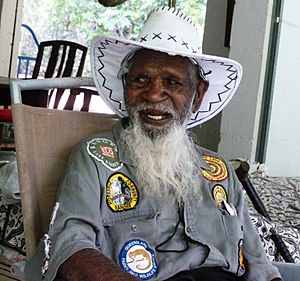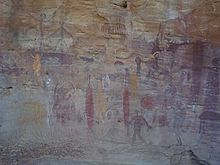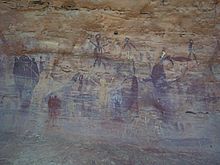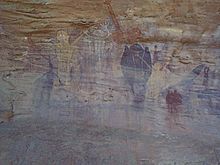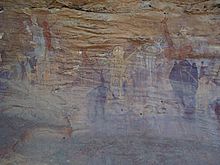Quinkan rock art facts for kids
Quick facts for kids Quinkan rock art |
|
|---|---|
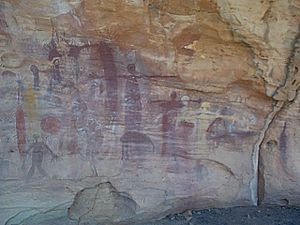
Example of Quinkan rock art 2002
|
|
| Location | near Laura, Queensland, Australia |
| Official name: Quinkan Country | |
| Type | Listed place |
| Designated | 10 November 2018 |
| Reference no. | 106262 |
| Lua error in Module:Location_map at line 420: attempt to index field 'wikibase' (a nil value). | |
Quinkan rock art is a special collection of ancient art made by Aboriginal people. This art is found on rock walls in the Laura area of Queensland, Australia. It's famous for showing unique characters called "Quinkans," who are important beings in Aboriginal stories. This whole area is known as Quinkan Country. Because it's so important, Quinkan Country was added to the Australian National Heritage List on November 10, 2018.
Contents
Where is Quinkan Country?
Quinkan rock art is found in a huge area of rugged sandstone cliffs and plateaus. This special place covers about 230,000 hectares. It's located about 4 kilometers (2.5 miles) southeast of Laura and 50 kilometers (31 miles) west of Cooktown.
Some parts of Quinkan Country are open for people to visit. You can take a guided tour with local Aboriginal guides. These tours are arranged by the Quinkan Regional Cultural Centre. One popular spot, Split Rock, is about 15 kilometers (9 miles) south of Laura. You can visit Split Rock on your own for a small fee. Other areas, known as the Quinkan Reserves, are owned by Aboriginal Trustees and are not open to the public.
Why is Quinkan Art Important?
The Quinkan rock art is considered one of the largest and most amazing collections of ancient art in the world. The paintings are usually big and have been kept in good condition for a very long time. There are also very old carvings in the rocks. Experts say the Quinkan art is outstanding because of how many different types there are, how much art there is, and how well it was made.
Two brothers, George Musgrave and Tommy George, spent their lives protecting this rock art. They also taught younger Aboriginal Traditional Owners about the history and stories connected to their land and the art. This helped keep the ancient knowledge alive for future generations.
What Does the Art Look Like?
The rock art in Quinkan Country includes different types: paintings, stencils, and engravings.
- Paintings: Most paintings show figures like people, animals, animal tracks, and mythical beings. They are usually made with one or two colors. Red ochre is the most common color, but you can also find white, yellow, black, and even a rare blue pigment.
- Stencils: These are made by holding an object against the rock and spraying paint around it, leaving the shape of the object.
- Engravings: These are carvings made directly into the rock. They can show both figures and abstract (non-realistic) designs.
Besides the rock art, Quinkan Country also has other important cultural sites. These include old campsites and places where Aboriginal people told stories. All of these show that Aboriginal people have lived in this area for a very long time.
In the 1870s, many European and Chinese miners came to Quinkan Country because of the Palmer River Goldrush. Thousands of miners traveled through this area between the goldfields and the port of Cooktown. Even with these big changes and new government rules, Aboriginal people have kept their strong connection to their land and culture.
Gallery


